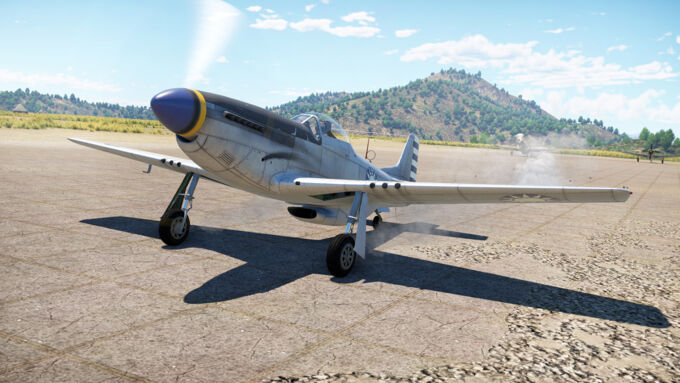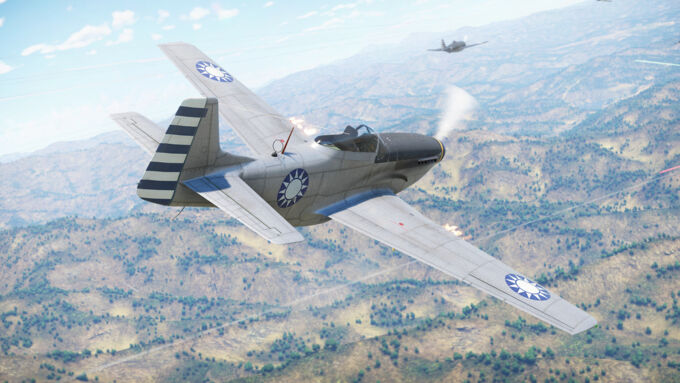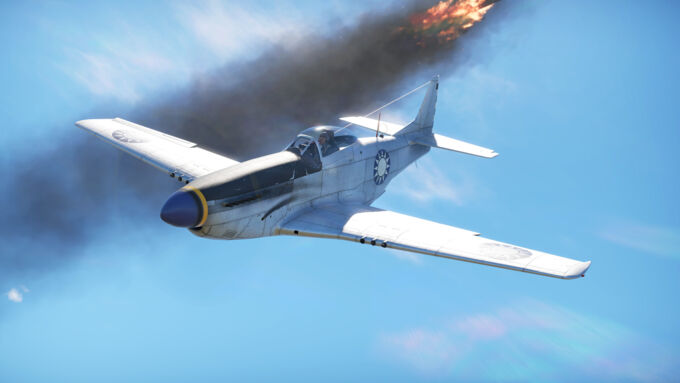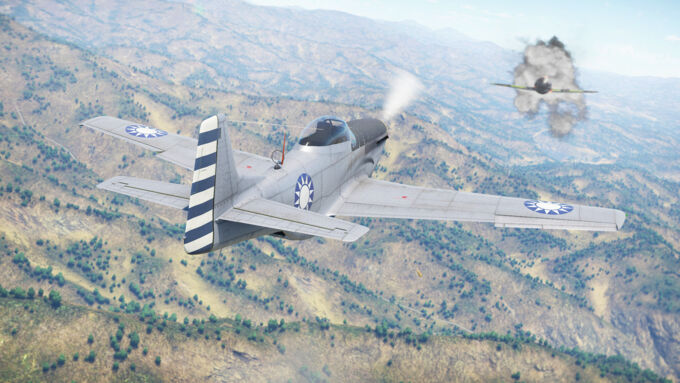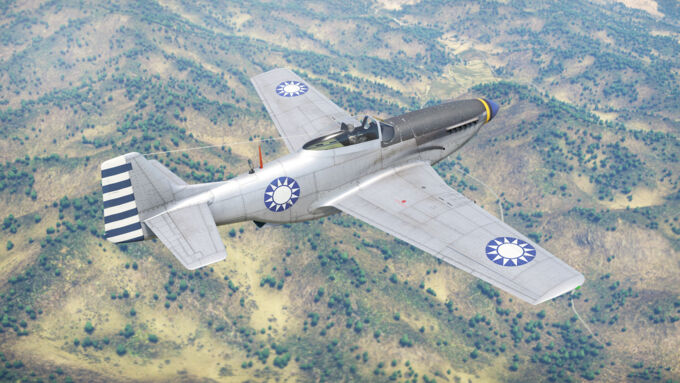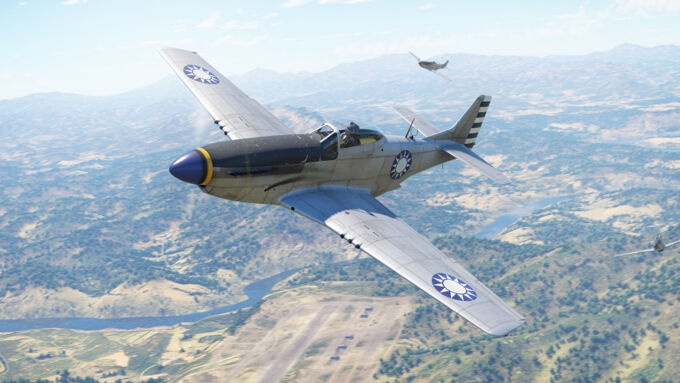The P-51K is the last variant of the P-51 available to the Chinese tech tree. While it may not look spectacularly different from the other P-51s available in the game, it does present flight characteristics similar to the P-51D-30 that players can utilize in their battle against opposing players.
Offense
Fighting fighters
Probably the best asset P-51K has is its speed and its ability to achieve and maintain it. Like with all planes, a higher attitude should be achieved first. Although its climb rate is nice, there are enough planes with better, and therefore, pilots of P-51K should plan ahead and not wait for the last second to climb. The best way to climb at the start is to climb towards the corner of the map so the enemy will be encountered later when P-51K is already high enough.
When an enemy is spotted heading in another direction than P-51K, this aircraft can enter a mild dive and go for a strafing run. After that, it is important to continue heading in the same direction so the speed is maintained. Even the most agile fighters won't be able to turn quickly enough to fire just one shot at you. If feeling confident or sure about the outcome, P-51K should get at least 2 km away from the enemy and then start to turn towards him, depending on its speed. If speed is under 500 km/h, a bigger distance should be achieved before attempting a turn. This ensures that turn will be completed before the enemy gets to 1 km distance, so you won't give your enemy opportunity for the first shot. However, head-on assault should be done only against weaker opponents, since .50 cal does not have the punch of 20 mm or 30 mm that similarly-ranked planes carry. A salvo of .50 cal rounds from the tracer belt can easily and often do ignite enemy engines upon impact, but a few hits from 30 mm will tear the wings of P-51 while fire can be taken out.
Fighting bombers
When engaging enemy bombers, aim for their engines. When an engine catches on fire, focus on another engine until it also burns, and so on. It is likely that fire will be taken out, but the damage done by 2 to 4 burning engines will be so severe that the enemy bomber will either crash within the next minute, even without one more hit, or he will lose altitude so much that it will be an easy target for lower flying teammates.
Bigger bombers like B-17 should not be followed for more than a few seconds, as the engine of P-51 is too fragile and often will turn red upon the first few hits, which gives you about 1 to 2 minutes before its engine dies completely. It is especially important to engage B-17 from a relatively higher altitude, gain a little more speed, and aim for engines. A well-aimed burst of tracer belt rounds should be enough to ignite 1 or 2 engines during this. Keep in mind that B17 can fly even with just one single engine and maintain its attitude and speed. Do not attempt to cut off the wings of bombers like with bigger guns, as it is quite hard to do so with .50 cal. When engaging a bomber with a huge glass cockpit like on He 111, a front assault with a salvo of .50 cal rounds has a high chance of knocking out its pilot with the number of rounds that will be fired.
Defense
Since this plane is designed for higher altitudes, you have to side-climb almost every time. Just like other American aircraft, the P-51 has the best performance above 4500 m, but the optimal altitude is between 4500 and 7000 m. The Mustang has a very bad climb rate when stock, so it's hard to reach altitudes, but there is no other option. Reaching an altitude of 6500 m should be enough. The correct mode to use this plane is similar to the Bf 109s: climb to altitude, choose the target, hit and run away, and repeat. The P-51 can do some nice turns at high speeds, but it quickly loses it. Never do more than 1 or 2 turns; you will bleed your energy. Luckily, you have nice energy retention and good diving characteristics, but as mentioned before, you need altitude to use this advantage.
It may seem that the agility of P-51 is lacking at first sight, but it is not that bad when used correctly. P-51 has a good turn rate at higher speeds, and its pilots should try to keep well above 400 km/h. When at a speed of around 500 km/h, even Spitfires will have trouble getting behind you. However, P-51 should avoid these encounters as this will bleed its speed to the point that P-51 will no longer be able to turn with the enemy. If a window of opportunity arises, for example, when an opponent starts his turn in the wrong direction after attempting to outmaneuver P-51K, P-51K can enter a mild dive and go for a run. P-51 can get to its top speed quite fast, especially when in a mild dive.
The top speed of the P-51K is one of the best in its rank. These three speed factors will help you run away from many opponents, giving you a chance to set your own rules of engagement with them. When running away with the enemy closing in, try to avoid climbing at all. If a climb is desired, it is best to wait until it is safe. If climbing cannot wait, try to climb below 10 degrees. When an enemy with a much higher speed is catching up with you at a higher altitude, a mild dive may not get you fast enough to your top speed. In these situations, a deep dive can be done. During this, the enemy will get even closer to P-51K. As the top speed of P-51 is quite high, after the enemy loses his initial speed advantage, P-51 will probably already start to get away. After this deep dive away, start to climb around 10 degrees.
P-51K is good at maintaining its speed, so it is likely that while P-51 will continue to move around 800-850 km/h after a deep dive for a couple of seconds, many opponents will quickly slow down to their listed top speed. This should be enough to provide a safe escape. If running away is not an option, a high-speed turn fight can be done for a short while. P-51 shouldn't prolong these encounters and should, as soon as possible, try to get away as already described in turn fights.
When an enemy is going head-on, he should be avoided. As already said, .50 cal cannot match 20 mm and bigger guns head-on. Additionally, such an encounter will probably damage the engine, which will take away the most important asset of P-51 and, after a few minutes, will lead to its failure. The vitality of the pilot is average, so he may survive, and so is the durability of its wings. However, the control surfaces of P-51 are quite fragile. Head-on should be done only with a weaker opponent, who has either much weaker armament or is already critically damaged.
If the engine turns red, airfields should be sought as fast as possible. With a red engine, try to climb as much as possible in a way that speed will be at least slowly increasing. When the engine dies, glide towards the airfield so that little to no speed is lost to avoid a stall. If speed reaches 200 km/h and dive is not possible if the airfield is to be reached, use flaps as they will keep you in the air for a little longer, even at a lower speed. If combat flaps are not enough and even then, P-51 starts to stall, raise flaps, open gear, use landing flaps, and retract gear. Landing flaps will keep you in the air for even longer than combat flaps, but if they are deployed too soon, they will serve as air brakes, which is not desired during glide.
Do not underestimate this plane because it has a bad performance when stock. Unlock the modifications and focus on the performance, especially the "compressor," "engine," and "fuselage repair" upgrades. When you're done with them, get the two weapon upgrades and, at last, survivability modules. You don't need to buy the G-suit if your crew has at least 4 points of G-tolerance and 3 points of stamina, but if you have enough silver lions in the bank, it can be useful for Boom and Zoom attacks and dogfights with heavier or comparable opponents.
Once you spade the P-51K, it gets a huge boost to climb rate, speed, and maneuverability, but you still have to avoid dogfights at low altitudes.
Screenshot credit: Gimei
